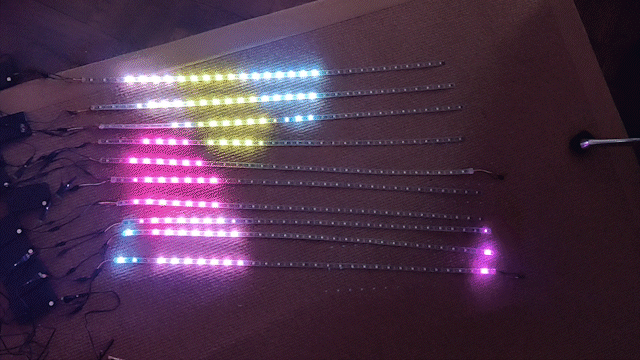







How To Kill One And Yourself was an interactive audio-visual exhibition of new music, sonic sculpture, and performance art for which I was a composer, sculptor, performer, lighting designer and animated visuals designer. It was centred around the theme of depicting emotional violence as physical violence as a means of articulating trauma and psychological self-harm narratives both fictional and non-fictional, and featured an album of new music, a custom built audio-reactive LED lighting system, various sonic sculptures, music videos, and moments of interactive performance art with attendees.
The lighting system was comprised of 10 strips of 30 of Adafruit’s Neopixels. For each of these strips, I built custom controllers (pictured on the left) with WiFi-enabled Feather microcontrollers (also manufactured by Adafruit). Because each strip was independently powered and because the patterns were transmitted wirelessly, the system could be flexibly deployed in a variety of configurations. The system was constructed to resemble an exploded display, wherein each LED would correspond to a single pixel in a 10x30 pixel digital canvas in Processing. This was achieved by generating visuals in Processing, downsampling each frame to a 10X30 pixel image, cutting the image into horizontal strips, and transmitting the color data in each of these strips to the Feather controllers as a UDP message. This methodology easily allows for the perception of visual continuity between physically discrete light strips even with very simple visual patterns.
Although in video form here, the visuals for “To be a vacuous rubber chamber” were generated live in the space with Processing and Max/MSP.
The music video for the track “To be seen and admired” was directed by @djtrashcap (see below).
The lighting system was comprised of 10 strips of 30 of Adafruit’s Neopixels. For each of these strips, I built custom controllers (pictured on the left) with WiFi-enabled Feather microcontrollers (also manufactured by Adafruit). Because each strip was independently powered and because the patterns were transmitted wirelessly, the system could be flexibly deployed in a variety of configurations. The system was constructed to resemble an exploded display, wherein each LED would correspond to a single pixel in a 10x30 pixel digital canvas in Processing. This was achieved by generating visuals in Processing, downsampling each frame to a 10X30 pixel image, cutting the image into horizontal strips, and transmitting the color data in each of these strips to the Feather controllers as a UDP message. This methodology easily allows for the perception of visual continuity between physically discrete light strips even with very simple visual patterns.
Although in video form here, the visuals for “To be a vacuous rubber chamber” were generated live in the space with Processing and Max/MSP.
The music video for the track “To be seen and admired” was directed by @djtrashcap (see below).